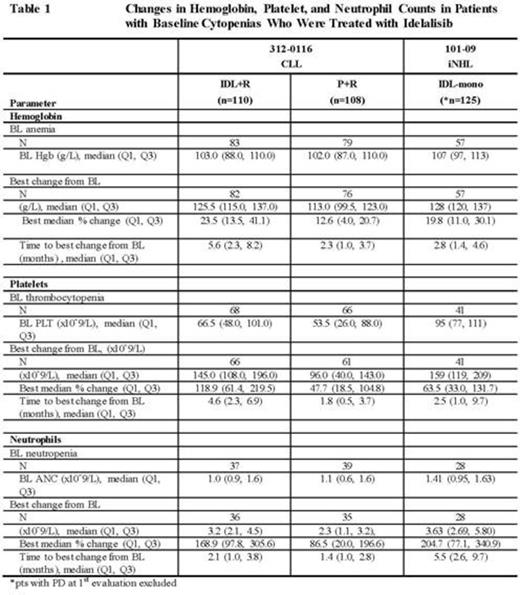Abstract
BACKGROUND
Chronic lymphocytic leukemia (CLL) and indolent non-Hodgkin lymphoma (iNHL) are B-cell malignancies associated with neutropenia, anemia and thrombocytopenia.The etiology of impaired hematopoiesis is not well understood, however the bone marrow leukemia/lymphoma cell infiltrates that often occur with these diseases is thought to contribute. In studies evaluating the selective PI3Kd inhibitor idelalisib (IDL) in B-cell malignancies, hematologic responses across all 3 lineages were observed in a majority of patients (pts) with baseline (BL) cytopenias.
This post hoc analysis reports hemogram changes in pts with relapsed or refractory (R/R) CLL/iNHL treated with IDL in two pivotal studies and describes trends in hematologic parameters over time during IDL treatment in pts with or without BL cytopenias.
METHODS
In phase 3 study 312-0116 (NCT01539512), frail pts with R/R CLL were randomized to receive a combination of 8 doses of rituximab (R) with IDL 150 mg BID or placebo (P). In phase 2 study 101-09 (NCT01282424), pts with refractory iNHL received IDL 150 mg BID. In both studies, IDL was continued until disease progression (PD) or unacceptable toxicity. Trial inclusion criteria allowed enrollment of pts with BL cytopenias of any grade (CLL) or grade ˂3 (iNHL).
Hematologic profiles for pts in each study were categorized as normal or abnormal (any grade of cytopenia) at BL. In the iNHL study, pts with PD at the first assessment were excluded from this analysis to avoid confounding by underlying uncontrolled disease.
RESULTS
A total of 345 pts participated in the 2 trials. The overall response rates of IDL-treated patients in the CLL and iNHL studies were 81% and 57%, respectively.
For pts with CLL on IDL+R (n=110), BL cytopenias (grade ≥1) included anemia (76%), thrombocytopenia (62%), and neutropenia (34%). For pts with iNHL on IDL-mono (n=115), BL cytopenias included anemia (50.4%), thrombocytopenia (64.3%), and neutropenia (75.7%). We present changes in hemoglobin (Hgb), platelet (PLT), or neutrophil (ANC) counts over time (BL, peak, and time to peak) in pts with an abnormal BL hemogram in Table 1.
Median hematologic lab values over time were unchanged in pts with normal hemograms at BL. Among patients with BL cytopenia, anemia and thrombocytopenia improved over time in pts with CLL and iNHL while on treatment with IDL. For pts with CLL, the magnitude of improvement was larger for pts in the IDL+R arm compared to those in the P+R arm. For pts in the IDL+R arm, median peak values of Hgb and PLT were observed within 6 months of IDL initiation. For pts with iNHL, median peak values for Hgb and PLT were observed within 3 months. ANC remained stable over time in CLL, and increased in iNHL.
CONCLUSIONS
Idelalisib treatment was associated with improvement in Hgb and PLT counts in this population of pts with R/R CLL or iNHL. In those pts with BL anemia or thrombocytopenia, peak improvement in Hgb or PLT values occurred early in treatment (≤3 months for iNHL and ≤6 months for CLL).
O'Brien:Gilead: Research Funding. Davies:Gilead: Honoraria, Membership on an entity's Board of Directors or advisory committees, Research Funding. Flinn:Cephalon, Inc; Teva Pharmaceutical Industries Ltd; Genentech, inc; Gilead: Research Funding. Gopal:Spectrum, Pfizer, BioMarin, Cephalon/Teva, Emergent/Abbott. Gilead, Janssen., Merck, Milennium, Piramal, Seattle Genetics, Giogen Idec, BMS: Research Funding; Gilead, Spectrum, Pfizer, Janssen, Seattle Genetics: Consultancy; Millennium, Seattle Genetics, Sanofi-Aventis: Honoraria. Kipps:Pharmacyclics Abbvie Celgene Genentech Astra Zeneca Gilead Sciences: Other: Advisor. Salles:Celgene Corporation; Roche and Gilead Sciences: Research Funding; Calistoga Pharmaceuticals, Inc.; Celgene Corporation; Genentech, Inc.; Janssen Pharmaceutica Products, L.P.; Roche: Consultancy; Celgene Corporation; Roche: Speakers Bureau. Newcomb:Gilead: Employment. Waldapfel:Gilead: Employment. Zhang:Gilead: Employment. Stilgenbauer:Gilead: Honoraria, Research Funding.
Author notes
Asterisk with author names denotes non-ASH members.


This feature is available to Subscribers Only
Sign In or Create an Account Close Modal